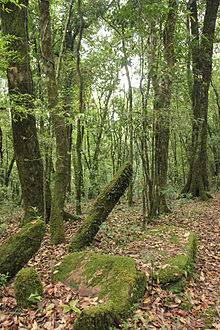

Sacred groves of India are forest fragments of varying sizes, which are communally protected, and which usually have a significant religious connotation for the protecting community. Hunting and logging are usually strictly prohibited within these patches.[1] Other forms of forest usage like honey collection and deadwood collection are sometimes allowed on a sustainable basis. NGOs work with local villagers to protect such groves. Traditionally, and in some cases even today, members of the community take turns to protect the grove.[2] The introduction of the protected area category community reserves under the Wild Life (Protection) Amendment Act, 2002 has introduced legislation for providing government protection to community held lands, which could include sacred groves.
Around 14,000 sacred groves have been reported across India, which act as reservoirs of rare fauna, and more often rare flora, amid rural and even urban settings. Experts believe that the total number of sacred groves could be as high as 100,000. Threats to the groves include urbanization, and over-exploitation of resources. While many of the groves are looked upon as abodes of Hindu deities, in the recent past a number of them have been partially cleared for construction of shrines and temples.[3][4] Sacred groves are places of yatra (pilgrimage) in Indian-origin religions, such as Hinduism, Buddhism and Jainism
Indian sacred groves are often associated with temples, monasteries, shrines, pilgrimage sites, or with burial grounds. Historically, sacred groves find their mention in Hindu, Jain and Buddhist texts, from sacred tree groves in Hinduism to sacred bamboo groves and sacred deer parks in Buddhism for example.[5] Sacred groves may be loosely used to refer to natural habitat protected on religious grounds. Other historical references to sacred groves can be obtained in Vrukshayurveda an ancient treatise, ancient classics such as Kalidasa's Vikramuurvashiiya. There has been a growing interest in creating green patches such as Nakshatravana grove.
- ^ Gadgil, M. and Vartak, V.D. ; Sacred groves of India : A plea for continued conservation Journal of Bombay Natural History Society, 72 : 314-320, 1975
- ^ "Community Forest Management and Joint Forest Management; An Ecological, Economic and Institutional Assessment in Western Ghats, India" (PDF). 2007-06-10. Archived from the original (PDF) on 2007-06-10. Retrieved 2018-08-07.
- ^ Malhotra, K. C., Ghokhale, Y., Chatterjee, S. and Srivastava, S., Cultural and Ecological Dimensions of Sacred Groves in India, INSA, New Delhi, 2001
- ^ Ramachandra Guha, The Unquiet Woods, University of California Press, 2000 (ISBN 978-0520222359)
- ^ Sen, Dr. A. (2008). Buddhist remains in India. Calcutta: Maha Bodhi Book Agency. pp. 30–34. ISBN 978-81-87032-78-6.